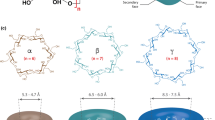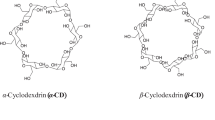Abstract
Fluorescence spectroscopy was used to characterize inclusion compounds between 4-amino-1,8-naphthalimides (ANI) derivatives and different cyclodextrins (CDs). The ANI derivatives employed were N-(12-aminododecyl)-4-amino-1,8-naphthalimide (mono-C12ANI) and N,N′-(1,12-dodecanediyl)bis-4-amino-1,8-naphthalimide (bis-C12ANI). The CDs used here were α-CD, β-CD, γ-CD, HP-α-CD, HP-β-CD and HP-γ-CD. The presence of CDs resulted in pronounced blue-shifts in the emission spectra of the ANI derivatives, with increases in emission intensity. This behavior was parallel to that observed for the dyes in apolar solvents, indicating that inclusion complexes were formed between the ANI and the CDs. Mono-C12ANI formed inclusion complexes of 1:1 stoichiometry with all the CDs studied. Complexes with the larger CDs (HP-β-CD, HP-γ-CD and γ-CD) were formed by inclusion of the chromophoric ANI ring system, whereas the smaller CDs (α-CD, HP-α-CD and β-CD) formed complexes with mono-C12ANI by inclusion of the dodecyl chain. Bis-C12ANI formed inclusion complexes of 1:2 stoichiometry with HP-β-CD, HP-γ-CD and γ-CD, but did not form inclusion complexes with α-CD, HP-α-CD and β-CD. The data were treated in the case of the large CDs using a Benesi-Hildebrand like equation, giving the following equilibrium constants: mono-C12ANI:HP-β-CD (K 11 = 50 M−1), mono-C12ANI:HP-γ-CD (K 11 = 180 M−1), bis-C12ANI:HP-β-CD (K 12 = 146 M−2), bis-C12ANI:HP-γ-CD (K 12 = 280 M−2).









Similar content being viewed by others
References
Alexiou, M.S., Tychopoulos, V., Ghorbanian, S., Tyman, J.H.P., Brown, R.G., Brittain, P.I.: The UV–visible absorption and fluorescence of some substituted 1,8-naphthalimides and naphthalic anhydrides. J. Chem. Soc. Perkin Trans. 2, 837–842 (1990)
Saha, S., Samanta, A.: Influence of the structure of the amino group and polarity of the medium on the photophysical behavior of 4-amino-1,8-naphthalimide derivatives. J. Phys. Chem. A 106, 4763–4771 (2002)
Prezhdo, O.V., Uspenskii, B.V., Prezhdo, V.V., Boszczyk, W., Distanov, V.B.: Synthesis and spectral-luminescent characteristics of N-substituted 1,8-naphthalimides. Dyes Pigments 72, 42–46 (2007)
Qian, J., Xu, Y., Qian, X., Wang, J., Zhang, S.: Effects of anionic surfactant SDS on the photophysical properties of two fluorescent molecular sensors. J. Photochem. Photobiol. A: Chem. 200, 402–409 (2008)
Loving, G., Imperiali, B.: A versatile amino acid analogue of the solvatochromic fluorophore 4-N,N-dimethylamino-1,8-naphthalimide: a powerful tool for the study of dynamic protein interactions. J. Am. Chem. Soc. 130, 13630–13638 (2008)
Yuan, D., Brown, R.G., Hepworth, J.D., Alexiou, M.S., Tyman, J.H.P.: The synthesis and fluorescence of novel N-substituted-1,8-naphthylimides. J. Heterocyclic Chem. 45, 397–404 (2008)
Mitchell, K.A., Brown, R.G., Yuan, D., Chang, S.C., Utecht, R.E., Lewis, D.E.: A fluorescent sensor for Cu2+ at the sub-ppm level. J. Photochem. Photobiol. A: Chem. 115, 157–161 (1998)
Bojinov, V.B., Georgiev, N.I., Bosch, P.: Design and synthesis of highly photostable yellow–green emitting 1,8-naphthalimides as fluorescent sensors for metal cations and protons. J. Fluorescence 19, 127–139 (2009)
Bojinov, V.B., Panova, I.P., Chovelon, J.-M.: Novel blue emitting tetra- and pentamethylpiperidin-4-yloxy-1,8-naphthalimides as photoinduced electron transfer based sensors for transition metal ions and protons. Sens. Actuators B: Chem. 135, 172–180 (2008)
Gunnlaugsson, T., Kruger, P.E., Jensen, P., Pfeffer, F.M., Hussey, G.M.: Simple naphthalimide based anion sensors: deprotonation induced colour changes and CO2 fixation. Tetrahedron Lett. 44, 8909–8913 (2003)
Veale, E.B., Gunnlaugsson, T.: Bidirectional photoinduced electron-transfer quenching is observed in 4-amino-1,8-naphthalimide-based fluorescent anion sensors. J. Org. Chem. 73, 8073–8076 (2008)
Gunnlaugsson, T., McCoy, C.P., Morrow, R.J., Phelan, C., Stomeo, F.: Towards the development of controllable and reversible ‘on-off’ luminescence switching in soft-matter; synthesis and spectroscopic investigation of 1,8-naphthalimide-based PET (photoinduced electron transfer) chemosensors for pH in water-permeable hydrogels. Arkivoc 2003, 216–228 (2003)
Ferreira, R., Remon, P., Pischel, U.: Multivalued logic with a tristable fluorescent switch. J. Phys. Chem. C 113, 5805–5811 (2009)
Greenfield, S.R., Svec, W.A., Gosztola, D., Wasielewski, M.R.: Multistep photochemical charge separation in rod-like molecules based on aromatic imides and diimides. J. Am. Chem. Soc. 118, 6767–6777 (1996)
Silva, A.P., Rice, T.E.: A small supramolecular system which emulates the unidirectional, path-selective photoinduced electron transfer (PET) of the bacterial photosynthetic reaction centre (PRC). Chem. Commun. 163–164 (1999)
Weiss, E.A., Sinks, L.E., Lukas, A.S., Chernick, E.T., Ratner, M.A., Wasielewski, M.R.: Influence of energetics and electronic coupling on through-bond and through-space electron transfer within U-shaped donor-bridge-acceptor arrays. J. Phys. Chem. B 108, 10309–10316 (2004)
Li, C., Du, P., Tian, H., Erk, P.: Novel thermochromic copolymers with two luminescent colors. Chem. Lett. 32, 570–571 (2003)
Niu, C.-G., Zeng, G.-M., Chen, L.-X., Shen, G.-L., Yu, R.-Q.: Proton “off-on” behaviour of methylpiperazinyl derivative of naphthalimide: a pH sensor based on fluorescence enhancement. Analyst 129, 20–24 (2004)
Qu, D.-H., Wang, Q.-C., Tian, H.: A half adder based on a photochemically driven [2]rotaxane. Angew. Chem., Int. Ed. 44, 5296–5299 (2005)
Qu, D.-H., Wang, Q.-C., Ma, X., Tian, H.: A [3]rotaxane with three stable states that responds to multiple-inputs and displays dual fluorescence addresses. Chem. Eur. J. 11, 5929–5937 (2005)
Ruf, A., Murcia, G., Schulz, G.E.: Inhibitor and NAD+ binding to poly(ADP-ribose) polymerase as derived from crystal structures and homology modeling. Biochemistry 37, 3893–3900 (1998)
Ryan, G.J., Quinn, S., Gunnlaugsson, T.: Highly effective DNA photocleavage by novel “rigid” Ru(bpy)3–4-nitro- and -4-amino-1,8-naphthalimide conjugates. Inorg. Chem. 47, 401–403 (2008)
Quaquebeke, E.V., Mahieu, T., Dumont, P., Dewelle, J., Ribaucour, F., Simon, G., Sauvage, S., Gaussin, J.-F., Tuti, J., Yazidi, M.E., Vynckt, F.V., Mijatovic, T., Lefranc, F., Darro, F., Kiss, R.: 2,2,2-Trichloro-N-({2-[2-(dimethylamino)ethyl]-1,3-dioxo-2,3-dihydro-1H-benzo[de]isoquinolin-5-yl}carbamoyl)acetamide (UNBS3157), a novel nonhematotoxic naphthalimide derivative with potent antitumor activity. J. Med. Chem. 50, 4122–4134 (2007)
Stewart, W.W.: Lucifer dyes—highly fluorescent dyes for biological tracing. Nature 292, 17–21 (1981)
Middleton, R.W., Parrick, J.: Preparation of 1,8-naphthalimides as candidate fluorescent probes of hypoxic cells. J. Heterocyclic Chem. 22, 1567–1572 (1985)
Lacivita, E., Leopoldo, M., Masotti, A.C., Inglese, C., Berardi, F., Perrone, R., Ganguly, S., Jafurulla, M., Chattopadhyay, A.: Synthesis and characterization of environment-sensitive fluorescent ligands for human 5-HT1A receptors with 1-arylpiperazine structure. J. Med. Chem. 52, 7892–7896 (2009)
Chang, S.C., Archer, B.J., Utecht, R.E., Lewis, D.E., Judy, M.M., Matthews, J.L.: 4-Alkylamino-3-bromo-N-alkyl-1, 8-naphthalimides: new photochemically activatable antiviral compounds. Bioorg. Med. Chem. Lett. 3, 555–556 (1993)
Chanh, T.C., Lewis, D.E., Judy, M.M., Sogandaresbernal, F., Michalek, G.R., Utecht, R.E., Skiles, H., Chang, S.C., Matthews, J.L.: Inhibition of retrovirus-induced syncytium formation by photoproducts of a brominated 1,8-naphthalimide compound. Antiviral Res. 25, 133–146 (1994)
Zhang, J., Woods, R.J., Brown, P.B., Lee, K.D., Kane, R.R.: Synthesis and photochemical protein crosslinking studies of hydrophilic naphthalimides. Bioorg. Med. Chem. Lett. 12, 853–856 (2002)
Szejtli, J.: Cyclodextrins and Their Inclusion Complexes. Akademiai Kiado, Budapest (1982)
Atwood, J.L., Davies, J.E.D., Macnicol, D.D., Vogtle, F. (eds.): Comprehensive Supramolecular Chemistry, Volume 3: Cyclodextrins. Pergamon, Oxford, UK (1996)
Szejtli, J.: Introduction and general overview of cyclodextrin chemistry. Chem. Rev. 98, 1743–1754 (1998)
Steed J.W., Atwood, J.L.: Supramolecular Chemistry, 2nd edn. Wiley, UK, chapter 6 (2009)
Nepogodiev, S.A., Stoddart, J.F.: Cyclodextrin-based catenanes and rotaxanes. Chem. Rev. 98, 1959–1976 (1998)
Brochsztain, S., Rodrigues, M.A., Politi, M.J.: Inclusion complexes of naphthalimide derivatives with cyclodextrins. J. Photochem. Photobiol. A: Chem. 107, 195–200 (1997)
Brochsztain, S., Politi, M.J.: Solubilization of 1,4,5,8-naphthalenediimides and 1,8-naphthalimides through the formation of novel host-guest complexes with α-cyclodextrin. Langmuir 15, 4486–4494 (1999)
Campos, I.B., Brochsztain, S.: Inclusion complexes of cyclodextrins with 4-amino-1,8-naphthalimides. J. Incl. Phenom. 44, 207–211 (2002)
Marcon, R.O., Brochsztain, S.: Characterization of self-assembled thin films of zirconium phosphonate/aromatic diimides. Thin Solid Films 492, 30–34 (2005)
Marcon, R.O., Santos, J.G., Figueiredo, K.M., Brochsztain, S.: Characterization of a novel water-soluble 3,4,9,10-perylenetetracarboxylic diimide in solution and in self-assembled zirconium phosphonate thin films. Langmuir 22, 1680–1687 (2006)
Ford, W.E.: Photochemistry of 3,4,9,10-perylenetetracarboxylic dianhydride dyes: visible absorption and fluorescence of the di(glycil)imide derivative monomer and dimer in basic aqueous solutions. J. Photochem. 37, 189–204 (1987)
Douhal, A. (ed.): Cyclodextrin Materials Photochemistry, Photophysics and Photobiology, 1st edn. Elsevier, Amsterdam (2006)
Connors, K.A.: Binding Constants: The Measurement of Molecular Complex Stability. Wiley, New York (1987), chapter 12
Hoshino, M., Imamura, M., Ikehara, K., Hama, Y.: Fluorescence enhancement of benzene derivatives by forming inclusion complexes with beta-cyclodextrin in aqueous solutions. J. Phys. Chem. 85, 1820–1823 (1981)
Acknowledgments
This work was supported by grants from Brazilian agency FAPESP (grant No. 05/51104-4 and 08/57940-7). S.B. thanks CNPq for a PQ scholarship. B.P.G.S. and R.O.M. are grateful to FAPESP for doctoral fellowships.
Author information
Authors and Affiliations
Corresponding author
Electronic supplementary material
Below is the link to the electronic supplementary material.
Rights and permissions
About this article
Cite this article
Silva, B.P.G., Marcon, R.O. & Brochsztain, S. Inclusion complexes of cyclodextrins with 4-amino-1,8-naphthalimides (part 2). J Incl Phenom Macrocycl Chem 68, 313–322 (2010). https://doi.org/10.1007/s10847-010-9790-8
Received:
Accepted:
Published:
Issue Date:
DOI: https://doi.org/10.1007/s10847-010-9790-8




